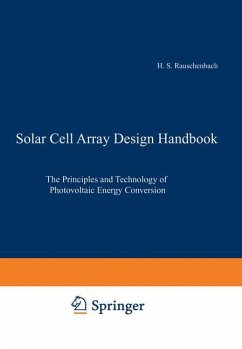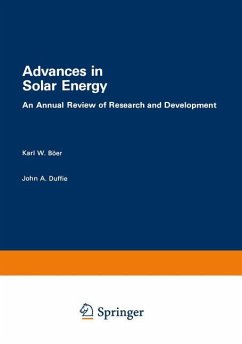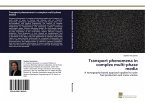I Solar Cell Arrays.- 1 Array Systems.- Array Concepts.- 1¿1. Arrays and Batteries.- 1¿2. Arrays, Panels, Parts, and Components.- 1¿3. Array Types.- 1¿4. The Array as Part of the Power System.- 1¿5. The Array as a System.- 1¿6. Hybrid Systems 6 Historical Developments.- 1¿7. History of Terrestrial Arrays.- 1¿8. History of Space Arrays.- 1 ¿9. The Future of Solar Cell Arrays.- Array Applications.- 1¿10. Terrestrial Applications.- 1¿11. Space Applications.- 1¿12. Power from Space.- Array Systems Performance.- 1¿13. Array Ratings.- 1¿14. Terrestrial Flat-Plate Arrays.- 1¿15. Terrestrial Concentrator Arrays.- 1¿16. Space Flat-Hate Arrays.- 1¿17. Spinning Space Arrays.- 1¿18. Space Concentrator Arrays.- 1¿19. Space Array Orbital Performance.- 2 Array Analysis.- Analytical Concepts.- 2¿1. The Role of Analysis.- 2¿2. Atoms and Electrons.- 2¿3. Electric Charge.- 2¿4. Conductors.- 2¿5. Insulators.- 2¿6. Current.- 2¿7. Electric Field.- 2¿8. Potential and Voltage.- 2¿9. Electrical Circuits.- 2¿10. Sources and Generators.- 2¿11. Current Flow Convection.- 2¿12. Resistance and Resistors.- 2¿13. Ohm¿s Law.- 2¿14. Power.- 2¿15. Energy.- 2¿16. Capacitance and Capacitors.- 2¿17. Magnetism.- 2¿18. Inductance and Inductors.- 2¿19. AC and DC Current.- 2¿20. Impedance.- Circuit Analysis.- 2¿21. Circuit Modelling.- 2¿22. Circuit Simplifications.- 2¿23. Circuit Responses.- 2¿24. Circuit Equations.- 2¿25. Operating Points.- Semiconductors and Solar Cell Models.- 2¿26. Quantum Mechanics.- 2¿27. Semiconductor Materials.- 2¿28. Semiconductor Junctions.- 2¿29. Solar Cell Operation.- 2¿30. Solar Cell Equation.- 2¿31. Solar Cell DC Model.- 2¿32. Distributed Parameter Solar Cell Model.- 2¿33. Analytical Models for Computer Work.- 2¿34. Non-Analytical Computer Models.- 2¿35. Selecting the Proper Model.- 2¿36. Solar Cell AC Model.- 2¿37. Solar Cells in Parallel and Series.- 2¿38. Illuminated Arrays.- 2¿39. Partially Shadowed Cells in Parallel.- 2¿40. Partially Shadowed Cells in Series.- 2¿41. Solar Cell Strings with Shunt Diodes.- 2¿42. Shadowing Factors.- 2¿43. Nonilluminated Array Models.- 2¿44. Blocking Diode Models.- 2¿45. Reverse-Biased Solar Cells.- 2¿46. Power Dissipation in Reverse-Biased Solar Cells.- Array Performance Prediction.- 2¿47. Array Output Analysis.- 2¿48. Sequence of Shifting I¿V Curves.- 2¿49. Calculation of Angle of Incidence.- 2¿50. Calculation of Effective Solar Intensity.- 2¿51. Calculation of Cell and Array I¿V Curves.- Shadow Analysis.- 2¿52. Shadows 84 Thermal Analysis.- Thermal Analysis.- 2¿53. Heat Flow and Temperature.- 2¿54. Heat Transfer by Conduction.- 2¿55. Heat Transfer by Convection.- 2¿56. Heat Transfer by Radiation.- 2¿57. Electrical Heat Transfer Analogy.- 2¿58. Terrestrial Array Operating Temperatures.- Reliability.- 2¿59. Reliability and Failure Rates.- 2¿60. Failure Modes and Effects.- 2¿61. Reliability Models.- Orbital Analysis.- 2¿62. Spacecraft Motion in Orbit.- 2¿63. Simplified Orbit Theory.- 2¿64. Altitude in Elliptic Orbits.- 2¿65. Location in Space.- 2¿66. Illumination of the Orbit Plane.- 2¿67. The Sun Angle.- 2¿68. Solar Eclipses.- 3 Array Design.- Design Concepts.- 3¿1. The Design Process.- 3¿2. Design Phases.- 3¿3. Design Personnel.- 3¿4. Uncertainties and Risks.- 3¿5. Design Optimization.- 3¿6. Design Requirements, Criteria and Interfaces.- 3¿7. Policy Constraints.- 3¿8. Design Review.- 3¿9. Producibility and Cost.- 3¿10. Human Engineering.- Photovoltaic System Design.- 3¿11. Load Profile Development.- 3¿12. Illumination Profile Development.- 3¿13. Preliminary Array Sizing¿Area Method.- 3¿14. Preliminary Array Sizing-Cell Efficiency Method.- 3¿15. Preliminary Array Sizing-Cell Power Method.- Detailed Array Design.- 3¿16. Detailed Array Sizing.- 3¿17. Space Array Configuration Selection.- 3¿18. Number of Required Solar Cells.- 3¿19. Array Layout.- 3¿20. Array Wiring.- 3¿21. Hot Spot Design Considerations.- 3¿22. Designing for Reliability.- 3¿23. High Voltage Design.- Thermal Design.- 3¿24. Temperature Control in Space.- 3¿25. Temperature Control on Earth.- 3¿26. Decreasing Absorptance.- 3¿27. Increasing Emittance.- 3¿28. Increasing Convection.- 3¿29. Improving the Geometry.- 3¿30. Minimizing Eclipse Exit Temperatures.- Radiation Shielding Design.- 3¿31. Solar Cell Radiation Shielding.- 3¿32. Damage-Equivalent Fluence in Orbit.- 3¿33. Shielding Thickness Determination.- 3¿34. Procedure for 1-MeV Fluence Analysis.- 3¿35. Shielding Against Low Energy Protons.- 3¿36. Absorbed Dose in Cover and Adhesive.- Electromagnetic Design.- 3¿37. Electrostatic Shielding.- 3¿38. Magnetic Cleanliness.- 3¿39. Minimizing Magnetic Moments.- 3¿40. Electrostatic Charging Control.- II Array Building Blocks.- 4 Solar Cells.- Photovoltaics.- 4¿1. Solar Cell Devices.- 4¿2. Direct Energy Conversion.- 4¿3. Discovery of the Photovoltaic Effect.- 4¿4. History of Contemporary Silicon Cells.- 4¿5. History of Non-Silicon Cells.- Solar Cell Types.- 4¿6. Solar Cell Classification.- 4 ¿ 7. Classification According to Application.- 4¿8. Classification According to Materials.- 4 ¿9. Classification According to Construction.- 4¿10. Classification According to Optical Features.- 4¿11. Contemporary Silicon Solar Cell Types for Space Use.- 4¿12. Contemporary Silicon Solar Cells for Terrestrial Use.- Electrical Characteristics.- 4¿13. Solar Cell Polarity.- 4¿14. Current-Voltage Characteristics.- 4¿15. Series Resistance.- 4¿16. Shunt Resistance.- 4¿17. Energy Conversion Efficiency.- 4¿18. Curve and Fill Factors.- 4¿19. Effects of Solar Intensity.- 4¿20. Reversible Effects of Temperature.- 4¿21. Temperature Coefficients.- 4¿22. Irreversible Temperature Effects.- 4¿23. High-Intensity, High-Temperature Operation.- 4¿24. Low-Intensity, Low-Temperature Operation.- 4¿25. Reverse Characteristics.- Optical Characteristics.- 4¿26. Effects of Optical Characteristics on Cell Efficiency.- 4¿27. Spectral Response Defined.- 4¿28. Spectral Response of Solar Cells.- Mechanical Characteristics.- 4¿29. Solar Cell Sizes and Shapes.- 4¿30. Cell Thicknesses.- 4¿31. Active Area.- Contacts.- 4¿32. Solar Cell Contact Types.- 4¿33. Contact Configurations.- 4¿34. Contact Strength.- Radiation Effects.- 4¿35. Solar Cell Radiation Damage.- 4¿36. Damage-Equivalent 1-MeV Fluence.- 4¿37. Effects of Base Resistivity.- 4¿38. Low-Energy Proton Damage.- 4¿39. Radiation Damage Annealing and Output Instabilities.- Practical Considerations.- 4¿40. Glassed Cell Output.- 4¿41. Distribution of Parameters.- 4¿42. Handling Precautions.- 4¿43. Storage.- 4¿44. Solar Cell Space Flight Experiments.- 4¿45. Laboratory Test Data for Space Cells.- 4¿46. Radiation Test Data for Space Cells.- 5 Optical Elements.- Functions of Optical Elements.- 5¿1. Flat-Plat Optics.- 5¿2. Concentrator Optics.- 5¿3. Historical Developments.- Optical Energy Transfer.- 5¿4. The Optical System.- 5¿5. The Air (or Space)-To-Cover Interface.- 5¿6. The Cover-To-Cell Interface.- 5¿7. Glassing Factors.- 5¿8. Angle-of-Incidence Effects.- 5¿9. Thermal Control.- Covers for Space Applications.- 5¿10. Classification of Covers and Coatings.- 5¿11. Cover Materials.- 5¿12. Coatings and Filters.- 5¿13. Mechanical Characteristics.- 5¿14. Conductive Coatings.- 5¿15. Cover Adhesives.- 5¿16. Integral Organic Covers.- Windows for Terrestrial Applications.- 5¿17. Window Construction.- 5¿18. Window Requirements.- 5¿19. Window Materials.- Sunlight Concentrators.- 5¿20. Principles of Sunlight Concentration.- 5¿21. Concentrator Types.- 6 Electrical Elements.- Solar Cell Interconnectors.- 6¿1. Interconnector Terminology.- 6¿2. Interconnector Types.- 6¿3. Solar Cell Interconnector Design Requirements.- 6¿4. Solar Cell and Interconnector Failure Modes.- 6 ¿ 5. Historical Developments of Solar Cell Interconnectors.- 6¿6. Soldered or Welded Joints?.- The Interconnector Design Problem.- 6 ¿ 7. Interconnector Material Selection.- 6¿8. Interconnector Electrical Design.- 6 ¿ 9. Minimizing Thermomechanical Stress.- 6¿10. Thermomechanical Stress in Rigid Joints.- 6¿11. Stresses in Joints Due to External Forces.- 6¿12. Changes in Intercell Gap Width.- 6¿13. Loop Deformation.- 6¿14. Stresses in Interconnector Expansion Loops.- 6¿15. Stress-free Interconnector Loops.- 6¿16. Stresses in Imbeded Interconnectors and Conductors.- 6¿17. Practical Interconnector Design Considerations.- 6¿18. Stresses in Flexible Bonded Layers.- Interconnector Fatigue.- 6¿19. Static and Dynamic Material Stress.- 6¿20. Stress and Strain Loading.- 6¿21. Fatigue of Materials.- 6¿22. Fatigue Life of Interconnectors.- Diodes.- 6¿23. Diode Applications.- 6¿24. Blocking Diodes for Energy Conservation.- 6¿25. Blocking Diodes for Fault Isolation.- 6¿26. Blocking Diode Characteristics.- 6¿27. Shunt Diode Use.- 6¿28. Shunt Diode Characteristics.- 6¿29. Zener Diodes.- Wiring and Cabling.- 6¿30. Wires and Cables.- 6¿31. Methods of Wiring.- 6¿32. Wiring for Terrestrial Arrays.- 6¿33. Wiring for Space Arrays.- 6¿34. Wire Insulation Properties.- 6¿35. Current Carrying Capability.- Terminals and Connectors.- 6¿36. Wire Terminations.- 6¿37. Connectors and Terminals for Space Arrays.- 6¿38. Connectors and Terminals for Terrestrial Use.- 6¿39. Termination Design Practices.- 7 Mechanical Elements.- Array Mechanical Characteristics.- 7¿1. Array Design Options.- 7¿2. Array Mechanical Elements.- Terrestrial Flat Hate Arrays.- 7¿3. Flat Plate Modules.- 7¿4. Open Frame Supports.- 7¿5. Roof Supports.- 7¿6. Flat Plate Orientation Mechanisms.- Terrestrial Concentrator Arrays.- 7¿7. Linear Concentrator Modules.- 7¿8. Axial Concentrator Modules.- 7¿9. Mirror Field Systems.- Space Arrays.- 7¿10. Space Array Overview.- 7¿11. Rigid Honeycomb Panels.- 7¿12. Honeycomb Panels With Stiffeners.- 7¿13. Flexible Substrates With Rigid Frames.- 7¿14. Flexible Fold-Up Blankets.- 7¿15. Flexible Roll-Up Blankets.- 7¿16. Hybrid Arrays.- 7¿17. Other Developments.- Deployment Mechanisms.- 7¿18. Deployable Booms.- 7¿19. Spring/Actuator Deployment Concepts.- Orientation Drives.- 7¿20. Orientation Mechanisms.- 7¿21. Stepping Drive Example.- 7¿22. Continuous Drive Example.- III Support Data.- 8 Fabrication and Test.- 8¿1. Soldering.- 8¿2. Welding.- 8¿3. Thermocompression Joining.- 8¿4. Ultrasonic Joining.- 8¿5. Electrical Degradation Due to Joining.- 8¿6. Adhesive Bonding.- Assembly Process Control.- 8¿7. Metal Joining Control.- 8¿8. Nondestructive Testing (NDT).- 8¿9. Adhesive Bonding Control.- 8¿10. Visual Inspection.- 8¿11. Workmanship Criteria.- Photovoltaic Testing.- 8¿12. History of Solar Cell-Testing.- 8¿13. Standard Solar Cells.- 8¿14. light Sources For Solar Cell-Testing.- 8¿15. Solar Simulators.- 8¿16. Solar Cell Output Measurements.- 8¿17. Array Output Measurements.- 8¿18. Standard Test Conditions.- 8¿19. Effects of Lead and Contact Resistances.- 8¿20. Three Types of Solar Cel- V Curves.- 8¿21. Measurement of Solar Cell Series Resistance.- 8¿22. Dark Forward-Testing.- 8¿23. Insulation Resistance and Voltage Breakdown.- Thermo-optical Measurements.- 8¿24. Measurement of Spectral Distribution and Spectral Response.- 8¿25. Determination of Solar Absorptance.- 8¿26. Determination of Hemispherical Emittance.- 8¿27. Measurement of Spectral Reflectance.- 8¿28. Measurement of Total Reflectance.- Environmental Testing.- 8¿29. Particle Radiation Testing.- 8¿30. Ultraviolet Radiation-Testing.- 8¿31. Far Ultraviolet Testing.- 8¿32. Combined Environments-Testing.- 8¿33. Temperature Cycling-Testing.- Significance of Test Data.- 8¿34. Errors.- 8¿35. Uncertainties.- 8¿36. Uncertainties in Inspection.- 8¿37. Significance of Sample Size.- 9 Environments and Their Effects.- 9¿1. The Solar Cell Array Environment.- Solar Energy.- 9¿2. The Sun.- 9¿3. The Solar Constant.- 9¿4. Albedo.- 9¿5. Solar Radiation Pressure.- 9¿6. Terrestrial Sunshine.- 9¿7. Ultraviolet Radiation.- Terrestrial Environments.- 9¿8. Temperature-Terrestrial.- 9¿9. Humidity.- 9¿10. Precipitation.- 9¿11. Wind.- 9¿12. Sand, Dust, Dirt.- 9¿13. Earthquakes.- 9¿14. Gravity.- 9¿15. The Atmosphere.- 9¿16. Atmospheric Electricity.- 9¿17. Corrosion.- 9¿18. Ozone.- 9¿19. Fungi and Bacteria.- 9¿20. Salt Spray.- 9¿21. Biotic Elements.- 9¿22. Vandalism.- Handling and Transportation.- 9¿23. Handling and Assembly.- 9¿24. Vibration and Acoustic Noise in Transportation.- 9¿25. Mechanical Shock in Transportation.- 9¿26. Storage.- 9¿27. Pressure/Altitude in Transportation.- Launch and Flight of Space Arrays.- 9¿28. Dynamic Forces During Launch and Flight.- 9¿29. Acceleration.- 9¿30. Shock (Mechanical).- 9¿31. Vibration.- 9¿32. Acoustic Field.- The Space Environment.- 9¿33. The Solar System.- 9¿34. The Space Vacuum.- 9¿35. Meteoroids.- 9¿36. Deposits.- 9¿37. Gravity in Space.- 9¿38. Time in Space.- 9¿39. Magnetic Fields.- 9¿40. Temperature in Space.- 9¿41. Solar Cell Arrays in Orbit.- 9¿42. Solar Eclipses.- The Radiation Environment in Space.- 9¿43. Radiation Terms.- 9¿44. Space Radiation and its Effects.- 9¿45. Radiation in Interplanetary Space.- 9¿46. Solar Flares.- 9¿47. Radiation Near Earth.- 9¿48. Radiation At Synchronous Altitude.- 9¿49. Geomagnetic Substorms.- 10 Material Properties.- 10¿1. Where to Find the Data.- 10¿2. Material Properties and the Designer.- General Characteristics.- 10¿3. Characteristics of Metals.- 10¿4. Characteristics of Non-metals.- 10¿5. Density, Mass and Weight.- 10¿6. Centroids, Moments of Inertia and Radii of Gyration.- Mechanical Properties.- 10¿7. Stress, Strain, and Strength.- 10¿8. Stiffness and Bending Stress.- 10¿9. Mechanical Properties as Function of Temperature.- 10¿10. Elongation and Reduction in Area.- 10¿11. Fatigue Life.- 10¿12. Mechanical Properties of Elastomers.- 10¿13. Outgassing and Weight Loss.- Thermal Properties.- 10¿14. Thermal Expansion.- 10¿15. Specific Heat and Heat Conductance.- Electromagnetic Properties.- 10¿16. Electrical Properties of Conductors.- 10¿17. Electrical Properties of Dielectrics.- 10¿18. Magnetic Properties.- 10¿19. Thermal Emittance 498 Appendices.- Appendices.- Appendix A Mathematics.- Appendix B Insolance Tables.- Appendix C Physical Constants.- Appendix D Conversion Factors and Formulas.- Appendix E 1 MeV Fluence Tables.








